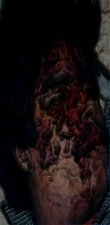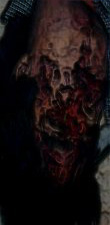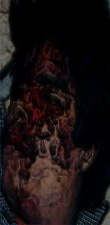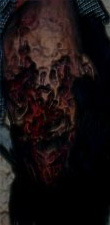

Iowa is probably best known as “the middle of nowhere.” Most non-residents consider the corn-and-pig-state a geographical black hole. Since rock’n’roll’s dawning in the early ’50’s, Iowa has had no singular voice to put on the musical map. Naming a significant musical identity from the state is inarguably a fruitless task; it simply can’t be done. However, nine freaks from Des Moines–draped in industrial coveralls, surrealistic self-made masks, and an attack that combines violently regurgitated “L.A. neo-metal,” death metal, hip-hop, and downtuned screeching horror–are about to leap upon the unsuspecting world like a musical of Clockwork Orange. Have you ever thought about what a messed-up hardcore metal band from “the middle of nowhere” would sound like? “Ultra-violence” only begins to descibe it…
Meet 0, 1, 2, 3, 4, 5, 6, 7, and 8. (In human terms that’s DJ Sid Wilson, drummer Joey Jordison, bassist Paul Gray, percussionist Chris Fehn, guitarist James Root, sampler Craig Jones, percussionist Shawn Crahan, guitarist Mick Thomson, and vocalist Corey Taylor, respectively.) Each comes equipped with not only a frightening visual persona and number assignment, but a talent on his particular instrument that combines and collides to form the nine-headed savior/destructor of modern heavy music dubbed Slipknot. Now, with the tools and talents (not to mention complex-yet-infectiously-catchy songs) that this band holds in its grasp, the world has no choice: Slipknot has arrived, and you must now decide how to deal with it.
Formed during the latter half of 1995, the band went through necessary lineup changes to arrive at what they now descibe as “a family unit.” All native Iowans, their rather unassuming, un-happening locale gave the members plenty of space and time to perfect their unusual take on heaviosity. The band recorded and distributed the self-released debut Mate. Feed. Kill. Repeat. in 1996, and the ball hasn’t stopped rolling since. Attracting the attention of a number of labels, Slipknot finally signed to Roadrunner through noted producer Ross Robinson’s I AM RECORDS imprint in 1997 and entered Indigo Ranch Studios in L.A. with Robinson to record Slipknot. From the pummeling Sic and the unforgiving bludgeon of Surfacing to the sublime melodies within Wait And Bleed and the hypnotizing rhythmic drive of Prosthetics, Slipknot’s vast array of influences comes seamlessly wrapped up in a 13-song love/hate letter to the outside world. The touring that will follow is promised to be “unlike anything else that’s going on out there. Seeing is believing.” So says Shawn Crahan. And it’s a gross understatement of what actually transpires when it all comes together on stage.
Until you hear the sound they create, having nine members in the band might seem ludicrous. Shawn claims it couldn’t work any other way: “We’ve maintained an excellent practice schedule for the last three years. Everybody’s on time, everybody’s always there, and we always practice as a unit. Our music is so reliant on each other that if one guy, even the DJ, is gone, it just wouldn’t be our songs without him. Without one person, something is really, really missing. Everybody has to be present. Even the littlest things make the songs magical.”
Just as striking visually as they are musically, Slipknot stresses that the visuals do not take precedence over the music. “We never put on the shit we wear to try and get people into us,” says Joey Jordison. “We did it because, after being degraded constantly for trying to play music or do something in Des Moines, it just came to be like we were an anonymous entity. No one gave a fuck, no one cared, so we were never about our names or our faces; we’re just about music. So we just put it on and it started gettin’ people, and it just started to turn into this big thing. The music’s the most important, though. The coveralls and masks happened, and for some reason it worked, therefore we had to kind of continue with it. We got stuck with it.”
Now that they’re stuck with it, they hardly feel like themselves without it. Shawn feels that “…the masks are extensions of our personalities. Everybody’s got sort of a tweaked, demented way about themselves, and we just alter the masks over time. It feels really, really good when we wear our masks for an hour, and then afterwards we take it off, and the first thing we do is go, ‘God, what a relief!’, but we always seem to put ’em back on after a show and walk around the place.” And the visual presentation will change over time, just as the music certainly will. “I think things will always be changing with Slipknot. Everybody grows older every year, and with that you change, and that’s somethin’ Slipknot is always going to do.”
As for the number assignments they wear on their coverall sleeves, they’re lucky numbers, significant and vitally important to each member. When choosing them, “Everybody fell into a number,” says Shawn. “There was not one person in the band arguing over a number. It was really weird.”
Thanks to a hefty Ross Robinson production job on Slipknot, Slipknot’s vision, part one, has been successfully realized. Shawn feels that Robinson was as highly motivated to work on the record as the band were to work with him. “We’re a highly, highly aggressive band, and very seldom do we meet people who are in the realm of our aggressiveness when we play as a unit, and Ross took us into the recording room and was throwing punches at us. He was into it. Ross got up every day and went and worked out so he could be in shape to do our album.”
The “shit” is wrapped up in a pretty little package called Slipknot. It’s the discordant sound of the middle of nowhere, a terrain where Slipknot is jester and king…

